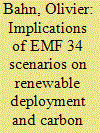|
|
|
Sort Order |
|
|
|
Items / Page
|
|
|
|
|
|
|
| Srl | Item |
| 1 |
ID:
126612


|
|
|
|
|
| Publication |
2013.
|
| Summary/Abstract |
This paper presents an analysis of Canadian energy and climate policies in terms of the coherence between federal and provincial/territorial strategies. After briefly describing the institutional, energy, and climate contexts, we perform a SWOT analysis on the themes of energy security, energy efficiency, and technology and innovation. Within this analytical framework, we discuss the coherence of federal and provincial policies and of energy and climate policies. Our analysis shows that there is a lack of consistency in the Canadian energy and climate strategies beyond the application of market principles. Furthermore, in certain sectors, the Canadian approach amounts to an amalgam of decisions made at a provincial level without cooperation with other provinces or with the federal government. One way to improve policy coherence would be to increase the cooperation between the different jurisdictions by using a combination of policy tools and by relying on existing intergovernmental agencies.
|
|
|
|
|
|
|
|
|
|
|
|
|
|
|
|
| 2 |
ID:
125750


|
|
|
|
|
| Publication |
2013.
|
| Summary/Abstract |
We use a newly developed bottom-up model of the entire Canadian energy system (TIMES-Canada) to assess potentials for electrification of the road transport sector. A special emphasis has been put on the modelling of the Canadian road transport, by considering a variety of vehicles for passenger and freight transportation. Besides a business-as-usual (baseline) scenario, we have analysed an energy policy scenario imposing targets for electric vehicle penetration and a climate policy scenario imposing targets for greenhouse gas emission reduction. Our analysis shows on the one hand that electric vehicles penetrate notably the passenger vehicle market after 2040 in the baseline scenario and after 2030 in the energy policy scenario (following the assumed penetration targets). On the other hand, the assumed climate policy forces a stronger penetration of electric vehicles for passenger transportation, with a progressive phasing out of internal combustion engine vehicles, whereas the latter vehicles remain dominant for freight transportation but with a shift away of fossil fuels and in favour of biofuels. A sensitivity analysis on the (assumed) evolution of electric vehicles over time confirms these general trends.
|
|
|
|
|
|
|
|
|
|
|
|
|
|
|
|
| 3 |
ID:
101405


|
|
|
|
|
| Publication |
2011.
|
| Summary/Abstract |
Paleoclimate evidence and climate models indicate that certain elements of the climate system may exhibit thresholds, with small changes in greenhouse gas emissions resulting in non-linear and potentially irreversible regime shifts with serious consequences for socio-economic systems. Such thresholds or tipping points in the climate system are likely to depend on both the magnitude and rate of change of surface warming. The collapse of the Atlantic thermohaline circulation (THC) is one example of such a threshold. To evaluate mitigation policies that curb greenhouse gas emissions to levels that prevent such a climate threshold being reached, we use the MERGE model of Manne, Mendelsohn and Richels. Depending on assumptions on climate sensitivity and technological progress, our analysis shows that preserving the THC may require a fast and strong greenhouse gas emission reduction from today's level, with transition to nuclear and/or renewable energy, possibly combined with the use of carbon capture and sequestration systems.
|
|
|
|
|
|
|
|
|
|
|
|
|
|
|
|
| 4 |
ID:
176830


|
|
|
|
|
| Summary/Abstract |
This paper proposes a detailed analysis of the evolution of Canadian energy systems under some selected EMF (Energy Modeling Forum) 34 scenarios. Our analysis is based on NATEM, an energy model that follows the TIMES approach of the International Energy Agency to represent in detail the energy sector of each of the 13 Canadian provinces and territories. NATEM shows that imposing different renewable penetration constraints for electricity generation has limited impacts outside the electricity sector. In particular, greenhouse gas (GHG) emissions continue to increase over time. Conversely, the imposition of a carbon tax has broader impacts on Canadian energy systems and on GHG emissions that are almost stabilized. However, the level of the carbon tax envisions by the EMF 34 study (increasing to a maximum level of $130 per tonne by 2050) is not high enough, in a Canadian context, to trigger a decrease of GHG emissions over time as mandated by Canadian climate policies.
|
|
|
|
|
|
|
|
|
|
|
|
|
|
|
|
|
|
|
|
|